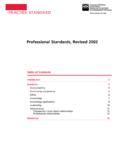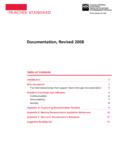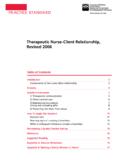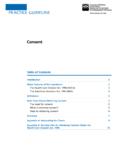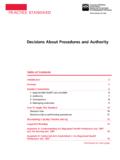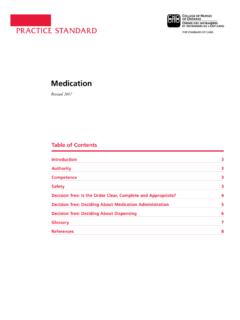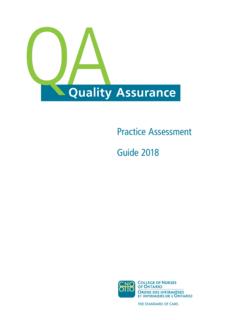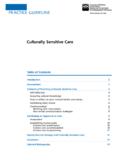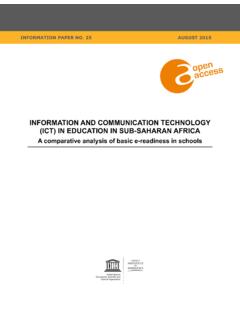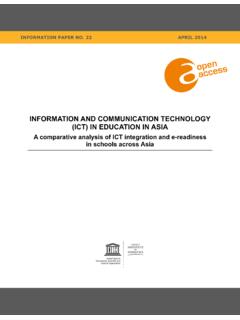Transcription of Competencies Entry-to-Practice for Registered Nurses
1 Entry-to-Practice Competenciesfor Registered Nurses Revised December. 2018 Table of Contents Introduction 3 Purpose of the document 3 Document background 3 Overarching principles 3 Definition of client 4 Competency framework 4 1. Clinician5 Coordinator7 d vo c a te7 Glossary 9 References 13 Acknowledgments The College of Nurses of Ontario (CNO) would like to thank CNO members who participated in the review and revision of this document.
2 CNO also recognizes and thanks the Canadian Council of Registered nurse Regulators: Revision of entry -Level Competencies Project Working Group for the foundational work on entry -level Competencies . Entry-to-Practice Competencies for Registered Nurses Pub. No. 41037 ISBN 978 -1-77116 -140 - 4 Copyright College of Nurses of Ontario, 2019. Commercial or for-profit redistribution of this document in part or in whole is prohibited except with the written consent of CNO. This document may be reproduced in part or in whole for personal or educational use without permission, provided that: Due diligence is exercised in ensuring the accuracy of the materials reproduced; CNO is identified as the source; and The reproduction is not represented as an official version of the materials reproduced, nor as having been made in affiliation with, or with the endorsement of, CNO.
3 First Published March 1999 as entry to Practice Competencies For Ontario Registered Nurses as of January 1, 2005, Updated June 2005, Revised February 2007. Revised June 2008 from the Jurisdictional Competency Process: entry -level Registered Nurses . Revised February 2009 as National Competencies in the context of entry -level Registering nurse practice. Adopted for Ontario Registered Nurses entry to-Practice Competencies (ISBN 978-1-77116-009-4). Updated June 2018 for title change- entry to Practice Competencies for Registered Nurses . Revised 2019. Additional copies of this booklet may be obtained by contacting CNO s Customer Service Centre at 416 928-0900 or toll-free in Canada at 1 800 387-5526. College of Nurses of Ontario 101 Davenport Rd. Toronto ON M5R 3P1 2 College of Nurses of Ontario Entry-to-Practice Competencies for Registered Nurses IntroductionThe College of Nurses of Ontario (CNO) is the regulatory body for nursing in Ontario.
4 Through provincial government legislation (Nursing Act, 1991 and Regulated Health Professions Act, 1991), CNO is accountable for public protection by ensuring Nurses in Ontario practice safely, competently and ethically. CNO fulfills its mandate through a variety of regulatory activities including registration, maintaining standards of nursing practice and education, enforcing nursing standards, conducting continuing competence reviews and establishing Competencies required for nursing practice. Entry-to-Practice Competencies are the foundation for nursing practice. This document outlines the Competencies measured for entry -level Registered Nurses (RNs) upon initial registration with CNO and entry to practice in Ontario. The Competencies also guide the assessment of members continuing competence for maintaining registration with CNO.
5 Purpose of the document The Competencies for entry -level RN practice are established for the following purposes: Protection of the public: Through government legislation (Nursing Act, 1991 and Regulated Health Professions Act, 1991), CNO is mandated by the public to promote and ensure safe, competent and ethical nursing in Ontario. Practice reference: The Competencies are used as a reference or resource to assist RNs to understand entry -level practice expectations and ongoing applications within their professional role. Approval of nursing education programs: The Competencies are used by CNO in evaluating baccalaureate nursing education programs to ensure the curriculum prepares graduates to successfully achieve professional practice standards before entry to practice.
6 Registration and membership requirements: The Competencies are used by CNO to inform registration eligibility decisions. Legal Reference: The legal definition of nursing practice included in the Nursing Act, 1991 establishes the basis for the scope of practice in which any nurse may engage. The Competencies are the expectations for RNs upon entry to practice in Ontario, and are used as a reference when evaluating the standard of care of Registered Nurses . Public information: The Competencies inform the public, employers, and other health care providers about Registered nursing practice, and assist with accurate expectations for Registered nursing practice at the entry level. Continuing competence: In accordance with CNO s Quality Assurance Program, the Competencies are used by members in the annual self-assessment of their nursing practice and development of professional learning goals.
7 Document background entry -level Competencies for RNs were first published by CNO in 2005 to align with the regulation change toward a university baccalaureate education requirement for RNs in Ontario. Since then, Competencies have been revised every five years at a national level to ensure practice relevance and consistency between jurisdictions. In 2017, the Canadian Council of Registered nurse Regulators initiated the most recent review and revisions of Entry-to-Practice Competencies for Registered Nurses in Canada. The initiative was led by a working group comprised of 11 provincial and territorial nursing regulatory bodies across the nation. This new set of revisions are based on results of an environmental scan, literature reviews and stakeholder consultation.
8 The regulatory body in each jurisdiction validates and approves the entry to-practice Competencies . They also confirm that the Competencies are consistent with provincial and territorial Overarching principles The following overarching principles apply to the education and practice of entry -level RNs: 1 Consistency between jurisdictions supports the workforce mobility requirements of the Canadian Free Trade Agreement. College of Nurses of Ontario Entry-to-Practice Competencies for Registered Nurses 3 RNs are beginning is unrealistic to expect an entry -level RNto function at the level of practice of anexperienced RNs work within the registerednursing scope of practice, and appropriatelyseek guidance when they encounter situationsoutside of their RNs must have the requisiteskills and abilities to attain the RNs are prepared as generalists topractice safely, competently, compassionately,and ethically: in situations of health and illness with all people across the lifespan with all recipients of care.
9 Individuals,families, groups, communities andpopulations across diverse practice settings using evidence-informed RNs have a strong foundationin nursing theory, concepts and knowledge,health and sciences, humanities, research andethics from education at the RNs practice autonomously withinlegislation, practice standards, ethics and scope of practice in their jurisdiction RNs apply the critical thinkingprocess throughout all aspects of of client The client is the central focus of Registered nursing practice. In the context of this document, client refers to a person who receives services from a Registered nurse . In most circumstances, the client is an individual, but the client can also include family members or substitute decision-makers. A client can also be a group, community or population.
10 Competency framework There is a total of 101 Competencies organized thematically under nine roles: 1: Conceptual framework for organizing competencies2 2 Copyright 2015 The Royal College of Physicians and Surgeons of Canada. Retrieved from canmeds/canmeds-framework-e. Adapted with permission. College of Nurses of Ontario Entry-to-Practice Competencies for Registered Nurses4 The model represents the multiple roles Nurses assume when providing, safe, competent, ethical, compassionate and evidence-informed nursing care in any practice setting. Some concepts are relevant to multiple roles. For the sake of clarity, and to avoid unnecessary repetition, certain key concepts (for example, client-centred) are mentioned once and applied to all Competencies .
